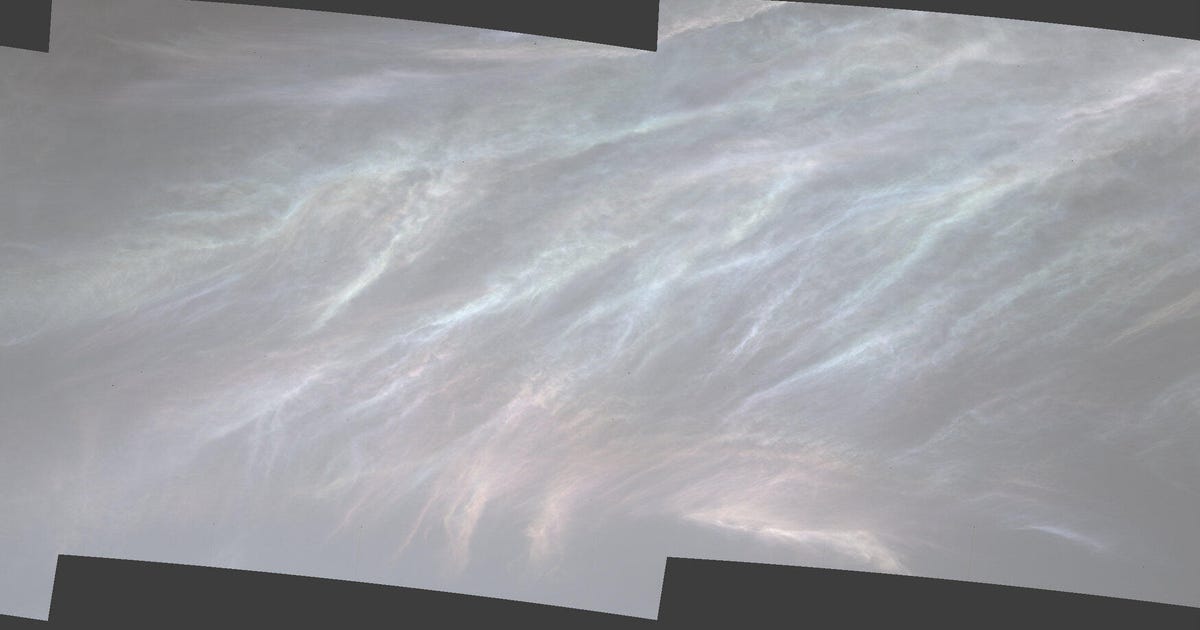
Clouds drift over Mount Sharp in the Gale Crater on March 19, 2021, as seen by NASA's Curiosity rover.
NASA/JPL-Caltech/MSSSMars has a lot of wind and dust devils, but, unlike Earth, it's not really famous for its clouds. That's one reason a collection of Martian cloud images from NASA's Curiosity rover is so stunning.
Scientists had noticed clouds starting to form on Mars earlier than expected, so this year they laid in wait to make sure Curiosity could capture the ethereal formations, some of which took on very colorful characteristics.
"More than just spectacular displays, such images help scientists understand how clouds form on Mars and why these recent ones are different," NASA said in statement on Friday.
Researchers discovered the earliest cloud arrivals appeared at higher altitudes. A typical Mars clouds would be made of water ice, something we see on Earth. But these high-flying clouds might actually be made of dry ice, frozen carbon dioxide. The idea is still under investigation.
Curiosity captured a suite of clouds views this year. You can watch the ghostly wisps moving in GIFs NASA put together. Some are examples of noctilucent "night-shining" clouds made of water ice. "Viewed just after sunset, their ice crystals catch the fading light, causing them to appear to glow against the darkening sky," said NASA.
The noctilucent clouds are made of water ice. Curiosity snapped them on March 31, 2021.
NASA/JPL-CaltechNoctilucent clouds also happen on Earth. Researchers watched them in our upper atmosphere last year in the Arctic. Sometimes they wander and become visible farther to the south.
Curiosity's Martian cloud scrapbook also included color images showing scenic "mother of pearl" clouds that glisten with an iridescent glow.
NASA's Curiosity rover snapped this panorama of "mother of pearl" clouds on Mars on March 5, 2021.
NASA/JPL-Caltech/MSSS"If you see a cloud with a shimmery pastel set of colors in it, that's because the cloud particles are all nearly identical in size," said atmospheric scientist Mark Lemmon with the Space Science Institute in Colorado. "That's usually happening just after the clouds have formed and have all grown at the same rate."
Lemmon said these ethereal clouds "are among the more colorful things" on Mars. It's like Mars decided it didn't want to be stereotyped as just the "red planet" anymore. As the pinks and blues and greens of the clouds show, it's got some range to its palette.
Follow CNET's 2021 Space Calendar to stay up to date with all the latest space news this year. You can even add it to your own Google Calendar.
https://news.google.com/__i/rss/rd/articles/CBMiUmh0dHBzOi8vd3d3LmNuZXQuY29tL25ld3MvbmFzYS1tYXJzLXJvdmVyLXNwb3RzLWlyaWRlc2NlbnQtbW90aGVyLW9mLXBlYXJsLWNsb3Vkcy_SAV1odHRwczovL3d3dy5jbmV0LmNvbS9nb29nbGUtYW1wL25ld3MvbmFzYS1tYXJzLXJvdmVyLXNwb3RzLWlyaWRlc2NlbnQtbW90aGVyLW9mLXBlYXJsLWNsb3Vkcy8?oc=5
2021-05-31 14:30:21Z
52781621502087
Tidak ada komentar:
Posting Komentar